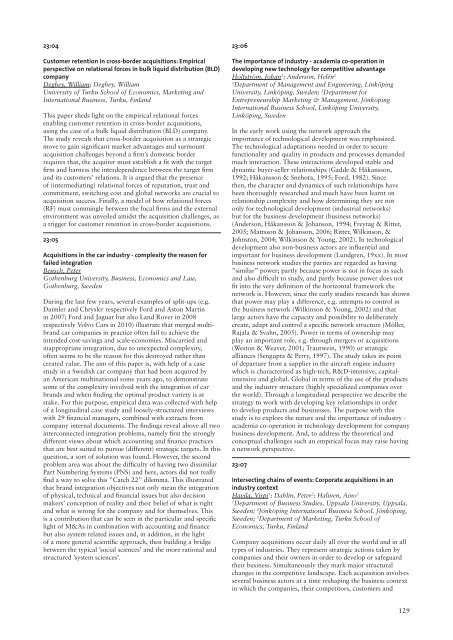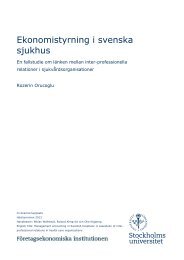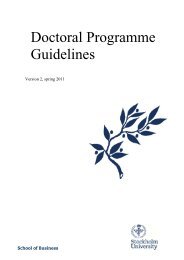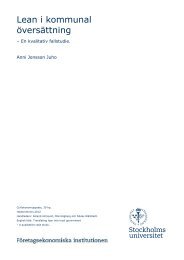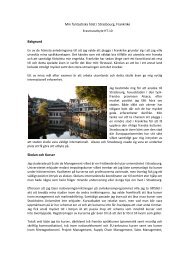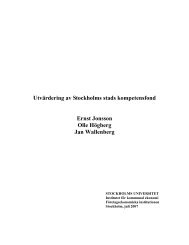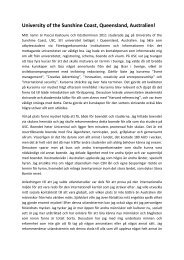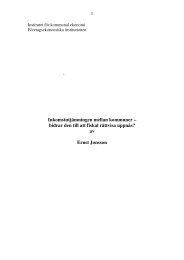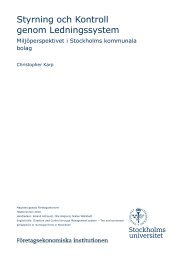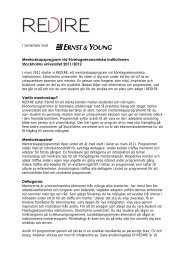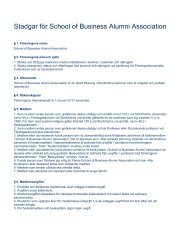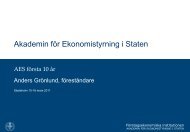Download full programme and abstract book pdf 1.6
Download full programme and abstract book pdf 1.6
Download full programme and abstract book pdf 1.6
You also want an ePaper? Increase the reach of your titles
YUMPU automatically turns print PDFs into web optimized ePapers that Google loves.
23:04<br />
Customer retention in cross-border acquisitions: Empirical<br />
perspective on relational forces in bulk liquid distribution (BLD)<br />
company<br />
Degbey, William; Degbey, William<br />
University of Turku School of Economics, Marketing <strong>and</strong><br />
International Business, Turku, Finl<strong>and</strong><br />
This paper sheds light on the empirical relational forces<br />
enabling customer retention in cross-border acquisitions,<br />
using the case of a bulk liquid distribution (BLD) company.<br />
The study reveals that cross-border acquisition as a strategic<br />
move to gain significant market advantages <strong>and</strong> surmount<br />
acquisition challenges beyond a firm’s domestic border<br />
requires that, the acquirer must establish a fit with the target<br />
firm <strong>and</strong> harness the interdependence between the target firm<br />
<strong>and</strong> its customers’ relations. It is argued that the presence<br />
of (intermediating) relational forces of reputation, trust <strong>and</strong><br />
commitment, switching cost <strong>and</strong> global networks are crucial to<br />
acquisition success. Finally, a model of how relational forces<br />
(RF) must commingle between the focal firms <strong>and</strong> the external<br />
environment was unveiled amidst the acquisition challenges, as<br />
a trigger for customer retention in cross-border acquisitions.<br />
23:05<br />
Acquisitions in the car industry - complexity the reason for<br />
failed integration<br />
Beusch, Peter<br />
Gothenburg University, Business, Economics <strong>and</strong> Law,<br />
Gothenburg, Sweden<br />
During the last few years, several examples of split-ups (e.g.<br />
Daimler <strong>and</strong> Chrysler respectively Ford <strong>and</strong> Aston Martin<br />
in 2007; Ford <strong>and</strong> Jaguar but also L<strong>and</strong> Rover in 2008<br />
respectively Volvo Cars in 2010) illustrate that merged multibr<strong>and</strong><br />
car companies in practice often fail to achieve the<br />
intended cost-savings <strong>and</strong> scale-economies. Miscarried <strong>and</strong><br />
inappropriate integration, due to unexpected complexity,<br />
often seems to be the reason for this destroyed rather than<br />
created value. The aim of this paper is, with help of a case<br />
study in a Swedish car company that had been acquired by<br />
an American multinational some years ago, to demonstrate<br />
some of the complexity involved with the integration of car<br />
br<strong>and</strong>s <strong>and</strong> when finding the optimal product variety is at<br />
stake. For this purpose, empirical data was collected with help<br />
of a longitudinal case study <strong>and</strong> loosely-structured interviews<br />
with 29 financial managers, combined with extracts from<br />
company internal documents. The findings reveal above all two<br />
interconnected integration problems, namely first the strongly<br />
different views about which accounting <strong>and</strong> finance practices<br />
that are best suited to pursue (different) strategic targets. In this<br />
question, a sort of solution was found. However, the second<br />
problem area was about the difficulty of having two dissimilar<br />
Part Numbering Systems (PNS) <strong>and</strong> here, actors did not really<br />
find a way to solve this ”Catch 22” dilemma. This illustrated<br />
that br<strong>and</strong> integration objectives not only mean the integration<br />
of physical, technical <strong>and</strong> financial issues but also decision<br />
makers’ conception of reality <strong>and</strong> their belief of what is right<br />
<strong>and</strong> what is wrong for the company <strong>and</strong> for themselves. This<br />
is a contribution that can be seen in the particular <strong>and</strong> specific<br />
light of M&As in combination with accounting <strong>and</strong> finance<br />
but also system related issues <strong>and</strong>, in addition, in the light<br />
of a more general scientific approach, then building a bridge<br />
between the typical ’social sciences’ <strong>and</strong> the more rational <strong>and</strong><br />
structured ’system sciences’.<br />
23:06<br />
The importance of industry - academia co-operation in<br />
developing new technology for competitive advantage<br />
Holtström, Johan 1 ; Anderson, Helén 2<br />
1 Department of Management <strong>and</strong> Engineering, Linköping<br />
University, Linköping, Sweden; 2 Department for<br />
Entrepreneurship Marketing & Management, Jönköping<br />
International Business School, Linköping University,<br />
Linköping, Sweden<br />
In the early work using the network approach the<br />
importance of technological development was emphasized.<br />
The technological adaptations needed in order to secure<br />
functionality <strong>and</strong> quality in products <strong>and</strong> processes dem<strong>and</strong>ed<br />
much interaction. These interactions developed stable <strong>and</strong><br />
dynamic buyer-seller relationships (Gadde & Håkansson,<br />
1992; Håkansson & Snehota, 1995; Ford, 1982). Since<br />
then, the character <strong>and</strong> dynamics of such relationships have<br />
been thoroughly researched <strong>and</strong> much have been learnt on<br />
relationship complexity <strong>and</strong> how determining they are not<br />
only for technological development (industrial networks)<br />
but for the business development (business networks)<br />
(Anderson, Håkansson & Johanson, 1994; Freytag & Ritter,<br />
2005; Mattsson & Johanson, 2006; Ritter, Wilkinson, &<br />
Johnston, 2004; Wilkinson & Young, 2002). In technological<br />
development also non-business actors are influential <strong>and</strong><br />
important for business development (Lundgren, 19xx). In most<br />
business network studies the parties are regarded as having<br />
”similar” power; partly because power is not in focus as such<br />
<strong>and</strong> also difficult to study, <strong>and</strong> partly because power does not<br />
fit into the very definition of the horizontal framework the<br />
network is. However, since the early studies research has shown<br />
that power may play a difference, e.g. attempts to control in<br />
the business network (Wilkinson & Young, 2002) <strong>and</strong> that<br />
large actors have the capacity <strong>and</strong> possibility to deliberately<br />
create, adapt <strong>and</strong> control a specific network structure (Möller,<br />
Rajala & Svahn, 2005). Power in terms of ownership may<br />
play an important role, e.g. through mergers or acquisitions<br />
(Weston & Weaver, 2001; Trautwein, 1990) or strategic<br />
alliances (Sengupta & Perry, 1997). The study takes its point<br />
of departure from a supplier in the aircraft engine industry<br />
which is characterized as high-tech, R&D-intensive, capitalintensive<br />
<strong>and</strong> global. Global in terms of the use of the products<br />
<strong>and</strong> the industry structure (highly specialized companies over<br />
the world). Through a longitudinal perspective we describe the<br />
strategy to work with developing key relationships in order<br />
to develop products <strong>and</strong> businesses. The purpose with this<br />
study is to explore the nature <strong>and</strong> the importance of industry -<br />
academia co-operation in technology development for company<br />
business development. And, to address the theoretical <strong>and</strong><br />
conceptual challenges such an empirical focus may raise having<br />
a network perspective.<br />
23:07<br />
Intersecting chains of events: Corporate acquisitions in an<br />
industry context<br />
Havila, Virpi 1 ; Dahlin, Peter 2 ; Halinen, Aino 3<br />
1 Department of Business Studies, Uppsala University, Uppsala,<br />
Sweden; 2 Jönköping International Business School, Jönköping,<br />
Sweden; 3 Department of Marketing, Turku School of<br />
Economics, Turku, Finl<strong>and</strong><br />
Company acquisitions occur daily all over the world <strong>and</strong> in all<br />
types of industries. They represent strategic actions taken by<br />
companies <strong>and</strong> their owners in order to develop or safeguard<br />
their business. Simultaneously they mark major structural<br />
changes in the competitive l<strong>and</strong>scape. Each acquisition involves<br />
several business actors at a time reshaping the business context<br />
in which the companies, their competitors, customers <strong>and</strong><br />
129


